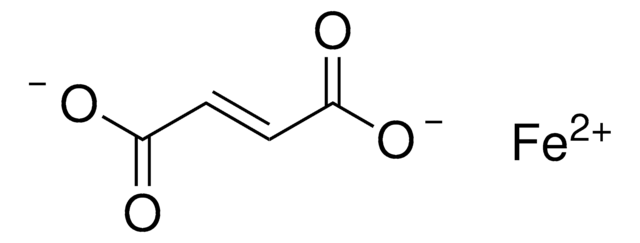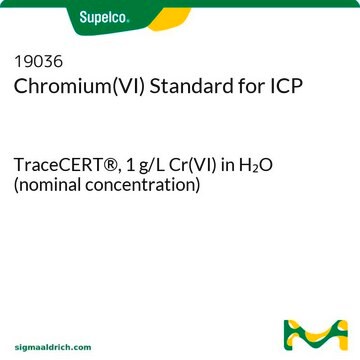EDFS
Ethylenediaminetetraacetic acid iron(III) sodium salt
powder
Sinónimos:
EDTA iron(III) sodium salt, Edathamil, Komplexon™ II
About This Item
Productos recomendados
origen biológico
synthetic (organic)
Nivel de calidad
Agency
suitable for SM 5210
formulario
powder
composición
Iron, 13.7-18.7% ICP
Sodium, 5.6-7.9% ICP
idoneidad de la reacción
reagent type: chelator
concentración
≥67.5% (EDTA titration)
pH
4.5
mp
80 °C
solubilidad
water: 50 mg/mL, clear to slightly hazy, yellow to brown
temp. de almacenamiento
room temp
cadena SMILES
[Na+].[Fe+3].[O-]C(=O)CN(CCN(CC([O-])=O)CC([O-])=O)CC([O-])=O
InChI
1S/C10H16N2O8.Fe.Na/c13-7(14)3-11(4-8(15)16)1-2-12(5-9(17)18)6-10(19)20;;/h1-6H2,(H,13,14)(H,15,16)(H,17,18)(H,19,20);;/q;+3;+1/p-4
Clave InChI
MKWYFZFMAMBPQK-UHFFFAOYSA-J
¿Está buscando productos similares? Visita Guía de comparación de productos
Categorías relacionadas
Aplicación
Información legal
Código de clase de almacenamiento
11 - Combustible Solids
Clase de riesgo para el agua (WGK)
WGK 2
Punto de inflamabilidad (°F)
Not applicable
Punto de inflamabilidad (°C)
Not applicable
Equipo de protección personal
dust mask type N95 (US), Eyeshields, Gloves
Certificados de análisis (COA)
Busque Certificados de análisis (COA) introduciendo el número de lote del producto. Los números de lote se encuentran en la etiqueta del producto después de las palabras «Lot» o «Batch»
¿Ya tiene este producto?
Encuentre la documentación para los productos que ha comprado recientemente en la Biblioteca de documentos.
Los clientes también vieron
Contenido relacionado
This page is intended to make it easier to find the consumables you need based on the analytical method you’re using. Methods included on this page come from the EPA, Standard Methods and ASTM.
Nuestro equipo de científicos tiene experiencia en todas las áreas de investigación: Ciencias de la vida, Ciencia de los materiales, Síntesis química, Cromatografía, Analítica y muchas otras.
Póngase en contacto con el Servicio técnico










